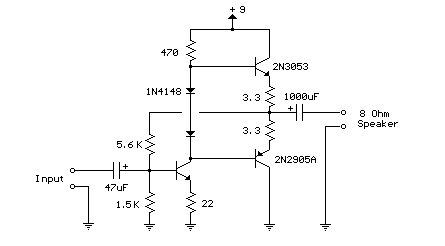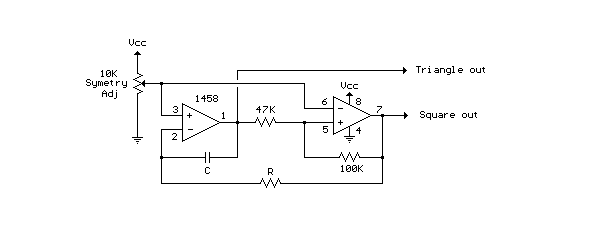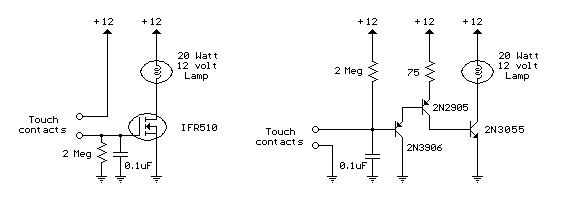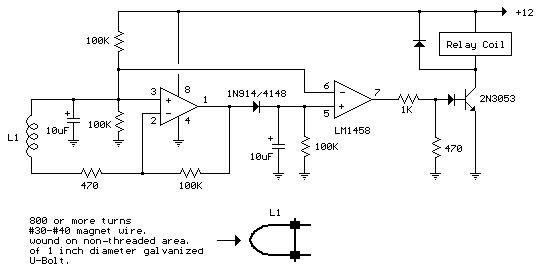3 Transistor Audio Amp (50 milliwatt)
Here is a little audio amplifier similar to what you might find in a
small transistor radio. The input stage is biased so that the supply
voltage is divided equally across the two complimentary output transistors
which are slightly biased in conduction by the diodes between the bases.
A 3.3 ohm resistor is used in series with the emitters of the output
transistors to stabilize the bias current so it doesn't change much with
temperature or with different transistors and diodes. As the bias current
increases, the voltage between the emitter and base decreases, thus
reducing the conduction. Input impedance is about 500 ohms and voltage
gain is about 5 with an 8 ohm speaker attached. The voltage swing on the
speaker is about 2 volts without distorting and power output is in the
50 milliwatt range. A higher supply voltage and the addition of heat sinks
to the output transistors would provide more power. Circuit draws about
30 milliamps from a 9 volt supply.

Menu
Telephone Audio Interface
Audio from a telephone line can be obtained using a transformer and capacitor
to isolate the line from external equipment. A non-polarized capacitor is
placed in series with the transformer line connection to prevent DC current
from flowing in the transformer winding which may prevent the line from
returning to the on-hook state. The capacitor should have a voltage rating
above the peak ring voltage of 90 volts plus the on-hook voltage of 48 volts,
or 138 volts total. This was measured locally and may vary with location,
a 400 volt or more rating is recommended. Audio level from the transformer is
about 100 millivolts which can be connected to a high impedance amplifier or
tape recorder input. The 3 transistor amplifier shown above can also be used.
For overvoltage protection, two diodes are connected across the transformer
secondary to limit the audio signal to 700 millivolts peak during the ringing
signal. The diodes can be most any silicon type (1N400X / 1N4148 / 1N914
or other). The 620 ohm resistor serves to reduce loading of the line if the
output is connected to a very low impedance.

Menu
LED Photo Sensor.
Here's a circuit that takes advantage of the photo-voltaic voltage of an ordinary
LED. The LED voltage is buffered by a junction FET transistor and then applied
to the inverting input of an op-amp with a gain of about 20. This produces a
change of about 5 volts at the output from darkness to bright light. The 100K
potentiometer can be set so that the output is around 7 volts in darkness and
falls to about 2 volts in bright light.

Menu
Triangle and Squarewave Generator
Here is a simple triangle/squarewave generator using a common 1458 dual
op-amp that can be used from very low frequencies to about 10 Khz. The
time interval for one half cycle is about R*C and the outputs will
supply about 10 milliamps of current. Triangle amplitude can be altered
by adjusting the 47K resistor, and waveform offset can be removed by
adding a capacitor in series with the output.

Menu
Low Frequency Sinewave Generators
The two circuits below illustrate generating low frequency sinewaves
by shifting the phase of the signal through an RC network so that
oscillation occurs where the total phase shift is 360 degrees. The transistor
circuit on the right produces a reasonable sinewave at the collector
of the 3904 which is buffered by the JFET to yield a low impedance
output. The circuit gain is critical for low distortion and you may need
to adjust the 500 ohm resistor to achieve a stable waveform with minimum
distortion. The transistor circuit is not recommended for practical
applications due to the critical adjustments needed.
The op-amp based phase shift oscillator is much more stable than the
single transistor version since the gain can be set higher than
needed to sustain oscillation and the output is taken from the
RC network which filters out most of the harmonic distortion.
The sinewave output from the RC network is buffered and the amplitude
restored by the second (top) op-amp which has gain of around 28dB. Frequency
is around 600 Hz for RC values shown (7.5K and 0.1uF) and can
be reduced by proportionally increasing the network resistors (7.5K).
The 7.5K value at pin 2 of the op-amp controls the oscillator circuit gain
and is selected so that the output at pin 1 is slightly clipped at the
positive and negative peaks. The sinewave output at pin 7 is about 5 volts
p-p using a 12 volt supply and appears very clean on a scope since the
RC network filters out most all distortion occurring at pin 1.

Menu
Touch Activated Light
The circuits below light a 20 watt lamp when the contacts are
touched and the skin resistance is about 2 Megs or less.
The circuit on the left uses a power MOSFET which turns
on when the voltage between the source and gate is around
6 volts. The gate of the MOSFET draws no current so the
voltage on the gate will be half the supply voltage or
6 volts when the resistance across the touch contacts is
equal to the fixed resistance (2 Megs) between the source and gate.
The circuit on the right uses three bipolar transistors to
accomplish the same result with the touch contact referenced
to the negative or ground end of the supply. Since the base
of a bipolar transistor draws current and the current gain is
usually less than 200, three transistors are needed to raise
the microamp current level through the touch contacts to a couple
amps needed by the light. For additional current, the lamp could be
replaced with a 12 volt relay and diode across the coil.

Menu
AC Line Current Detector
This circuit will detect AC line currents of about 250 mA or more without
making any electrical connections to the line. Current is detected by passing
one of the AC lines through an inductive pickup (L1) made with a 1 inch
diameter U-bolt wound with 800 turns of #30 - #35 magnet wire. The pickup
could be made from other iron type rings or transformer cores that allows
enough space to pass one of the AC lines through the center. Only one of the
current carrying lines, either the line or the neutral should be put through
the center of the pickup to avoid the fields cancelling. I tested the circuit
using a 2 wire extension cord which I had separated the twin wires a small
distance with an exacto knife to allow the U-bolt to encircle only one wire.
The magnetic pickup (U-bolt) produces about 4 millivolts peak for a AC line
current of 250 mA, or AC load of around 30 watts. The signal from the pickup
is raised about 200 times at the output of the op-amp pin 7 which is then
peak detected by the capacitor and diode connected to pin 7. The second
op-amp is used as a comparator which detects a voltage rise greater than the
diode drop. The minimum signal needed to cause the comparator stage output
to switch positive is around 800 mV peak which corresponds to about a 30 watt
load on the AC line. The output 1458 op-amp will only swing within a couple
volts of ground so a voltage divider (1K/470) is used to reduce the no-signal
voltage to about 0.7 volts. An additional diode is added in series with the
transistor base to ensure it turns off when the op-amp voltage is 2 volts.
You may get a little bit of relay chatter if the AC load is close to the
switching point so a larger load of 50 watts or more is recommended. The
sensitivity could be increased by adding more turns to the pickup.

Menu
Digital Electronic Lock
The digital lock shown below uses 4 common logic ICs to allow controlling
a relay by entering a 4 digit number on a keypad. The first 4 outputs from
the CD4017 decade counter (pins 3,2,4,7) are gated together with 4 digits
from a keypad so that as the keys are depressed in the correct order, the
counter will advance. As each correct key is pressed, a low level appears
at the output of the dual NAND gate producing a high level at the output
of the 8 input NAND at pin 13. The momentary high level from pin 13
activates a one shot circuit which applies an approximate 80 millisecond
positive going pulse to the clock line (pin 14) of the decade counter
which advances it one count on the rising edge. A second monostable,
one shot circuit is used to generate an approximate 40 millisecond positive
going pulse which is applied to the common point of the keypad so that
the appropriate NAND gate will see two logic high levels when the correct
key is pressed (one from the counter and the other from the key). The
inverted clock pulse (negative going) at pin 12 of the 74C14 and the
positive going kepad pulse at pin 6 are gated together using two diodes
as an AND gate (shown in lower right corner). The output at the junction of
the diodes will be positive in the event a wrong key is pressed and will
reset the counter.
When a correct key is pressed, outputs will be present from both
monostable circuits (clock and keypad) causing the reset line to remain
low and allowing the counter to advance. However, since the keypad pulse
begins slightly before the clock, a 0.1uF capacitor is connected
to the reset line to delay the reset until the inverted clock arrives.
The values are not critical and various other timing schemes could be used
but the clock signal should be slightly longer than the keypad pulse so that
the clock signal can mask out the keypad and avoid resetting the
counter in the event the clock pulse ends before the keypad pulse. The
fifth output of the counter is on pin 10, so that after four correct
key entries have been made, pin 10 will move to a high level and can
be used to activate a relay, illuminate an LED, ect. At this point,
the lock can be reset simply by pressing any key. The circuit can be
extended with additional gates (one more CD4011) to accept up to a 8
digit code. The 4017 counting order is 3 2 4 7 10 1 5 6 9 11 so that
the first 8 outputs are connected to the NAND gates and pin 9 would
be used to drive the relay or light. The 4 additional NAND gate outputs
would connect to the 4 remaining inputs of the CD4068 (pins 9,10,11,12).
The circuit will operate from 3 to 12 volts on 4000 series CMOS but only
6 volts or less if 74HC parts are used. The circuit draws very little
current (about 165 microamps) so it could be powered for several months
on 4 AA batteries assuming only intermittent use of the relay.

Menu
�






